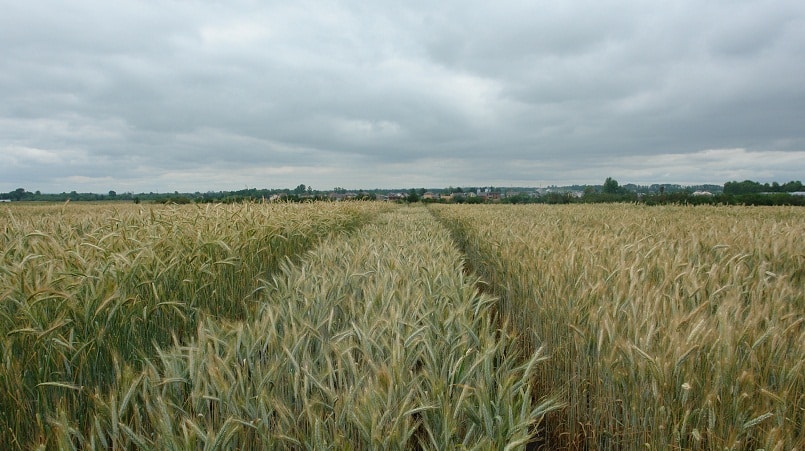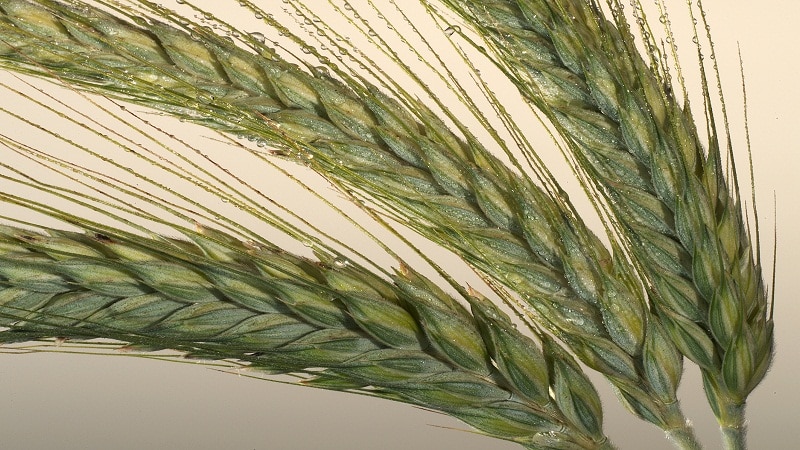What is triticale, what does it look like and where is it used?
The science of selection puts into practice humanity’s dreams of universal, unpretentious, maximally useful products that require minimal care and produce maximum yield. An example of such a dream come true is triticale, a viable and fertile hybrid of rye and wheat.
What triticale looks like, what are its features, benefits and applications - you will find all this in our article.
Triticale - what is it?
Triticale is a hybrid plant (amphidiploid), obtained by crossing representatives of two different genera of cereal plants - wheat and rye. This culture has no analogues in nature and combines the best qualities of its parent forms.
Reference. An amphidiploid is a fertile hybrid organism that combines the complete chromosome sets of both parental species. Amphidiploids differ from ordinary hybrids in their ability to reproduce while maintaining unique properties.
Triticale is used mainly as a fodder crop, but has excellent prospects for producing baking flour from grain.
What does it look like
The plant has all the morphological characteristics of cereals: straight large leaves, an inflorescence-spike and a caryopseal fruit.

Botanical description
The plant is classified as a separate genus. The name triticale comes from the Latin Triticum (“wheat”) and Secale (“rye”).
The genus includes three species of triticale:
- two-species octoploid obtained by crossing rye and bread wheat;
- two-species hexaploid - a hybrid of rye and durum wheat;
- trispecies hexaploid - the result of a combination of rye, durum and soft wheat.
The roots are fibrous and penetrate 1.5 m or more deep into the soil.
The stem has 5-7 internodes, is hollow, sometimes pubescent under the spike. The height of grain varieties is 70-120 cm, forage varieties are from 120 to 180 cm. The thick stem at the base ensures resistance to lodging even for tall varieties.
The leaves are lanceolate, up to 35 cm long, up to 3 cm wide. The color is dark green or glaucous, with a waxy coating. The foliage forms earlier than that of wheat and remains green longer, which improves the nutrition of the ear with photosynthetic products.
The inflorescence is a complex spike of a complete type (with an apical spikelet). 30-40 spikelets are formed on the spikelet. Each of them contains three developed flowers, from which three grains are formed. The spike, up to 15 cm long, has a spindle-shaped or cylindrical shape. The plant is self-pollinating.
The fruit of triticale is a yellowish-brown grain. The ripened grain does not fall off. The fruit size is 10-12 mm in length and about 3 mm in width. The surface is wrinkled, with a groove in the center and a pronounced tuft at the top. The weight of a thousand grains is 40-60 g.
Brief history of appearance
Breeders have long dreamed of combining the nutritional value of wheat grain and the unpretentiousness of rye.
Work on crossing wheat and rye began at the end of the 19th century. The first hybrid was obtained in 1875 by Wilson, but the plant turned out to be sterile. Further work made it possible to grow lines that split in the second generation according to the characteristics of the parental forms.
Only in 1888, the German scientist W. Rimpau developed a new type of cereal capable of reproduction.
In the USSR, wheat-rye hybrids began to be produced starting in 1920.
By 2018, 85 triticale varieties were registered in Russia in the State Register of Breeding Achievements.
Plant characteristics
The new crop has enormous yield potential and resistance to adverse weather conditions, diseases and pests. Main characteristics of the plant:
- Frost resistance. The wheat-rye hybrid is not demanding on heat. Sprouts appear at +1-2ºС. Seedlings tolerate temperature drops to minus 3-6ºС. Winter forms survive at temperatures of minus 18-20ºС in the area of the tillering node (2-3 cm deep into the soil).
- Drought resistance. The moisture requirement is less than that of wheat. Only during periods of intensive growth is there a need for irrigation. The culture can withstand temperatures up to 40ºС.
- Attitude to light. Triticale is a long-day plant. It responds to sunny weather combined with sufficient humidity with an increased yield. More nutrients and sugars accumulate in leaves and grains.
- Soil requirements. The hybrid produces high yields even on poor soils. It is successfully cultivated on wood-podzolic, gray, forest, light loamy and sandy loam soils.
- Resistance to pests and diseases. The hybrid is less susceptible to common cereal diseases (fusarium, septoria, leaf rust). Triticale grain is not subject to “potato disease”, since rye genes provide resistance to pathogenic microflora.
- Productivity. With good agricultural technology, the yield of grain varieties is 50-80 c/ha, forage varieties - up to 60 c/ha. Forage varieties produce 500-600 centners of green mass per hectare, and with irrigation even more. For comparison, the average wheat yield is 22.5 c/ha.The increased yield of triticale at lower seeding rates is explained by the tendency to tillering, which it inherited from rye.
Features of cultivation

Triticale is grown mainly in Poland, Germany and Belarus. In Russia, the area under crops of this cereal covers about 500 thousand hectares.
Implementation is slow. This is believed to be due to difficulties in processing the product. The main difficulty lies in grain processing. Due to biological features, it is difficult to separate the membranes from the endosperm.
Innovative cultivation technologies
Podzolic or turf soils with an acidity of 5.5-6.5 pH are suitable for growing triticale. This crop does not tolerate excess moisture, so it is not recommended to sow it in heavy, poorly drained soils. The content of the main nutrients, potassium and phosphorus, should not be 150 mg/kg.
Soil preparation is no different from the technology of cultivating wheat and rye. Organic fertilizers are applied at the rate of 30 tons per hectare, nitrogen fertilizers - 80-90 kg per hectare. Before sowing, cultivation is carried out.
Planted using standard row sowing with a row spacing of 8-15 cm.
Sowing of winter varieties in the northern regions begins in the middle - end of August, in the southern regions - at the end of September. Spring forms are planted 3-8 days after the soil has completely thawed. According to intensive technology, the seeding depth is 2-3 cm.
The best predecessors of triticale are: corn, potatoes, forage grasses, buckwheat. It is not recommended to plant after wheat and other grains.
A few weeks before sowing, the seeds are treated against diseases. In this case, seed moisture should not exceed 14%. Use seed with a mass of at least 40 g per 1000 pieces.
Herbicides are used to control weeds.Treatment is carried out 1-2 days after sowing and before emergence.
Pesticides are used against diseases and parasites (snow mold, aphids, Swedish flies). The type of chemicals applied depends on the type of weeds and pests.
Triticale harvesting for commercial purposes is carried out at a grain moisture content of 24-26%, for seed purposes - less than 20%. Considering that triticale grain tends to germinate on the root, the crop is harvested first.
Important. The grain of the cereal is larger than that of wheat and rye. Therefore, when threshing, the equipment settings are changed to avoid grain crushing.
Varieties of triticale
Depending on the purpose, the hybrid is divided into three groups: grain, grain-forage, and fodder. Depending on the sowing time, winter and spring crops are distinguished.
Examples of grain group varieties:
- Altaiskaya 5 - a winter variety recommended for cultivation in the West Siberian region. The average grain yield in the region is 32.6 c/ha, the maximum is 70 c/ha. The height of the bushes is 105-139 cm, resistance to lodging is above average. Resistant to stem rust, powdery mildew, hard and dusty smut, snow mold.
- Amphidiploid 256 - winter triticale, recommended for the North Caucasus region. The average yield is 43.6 c/ha. Resistant to lodging, shedding and drought. The grain is suitable for the food industry.
- Yarilo - a spring form of grain fodder, suitable for cultivation in the North Caucasus District. Productivity - 25 c/ha. It is resistant to lodging, has immunity to fusarium, head smut, powdery mildew and other diseases.
Forage varieties are characterized by high stems (up to 170 cm), large leaves, and late heading. The green mass has high feeding qualities. This group includes varieties:
- Argo - a winter variety for obtaining green mass, making silage and hay. Approved for cultivation in the Central, Volga-Vyatka, Central Black Earth, North Caucasus and Lower Volga regions. The maximum green yield is 180 c/ha. Not affected by brown rust, septoria, viral spotting.
- Tornado - winter variety. Cultivated in the Volga-Vyatka, Central Black Earth, North Caucasus, and Middle Volga districts. Plant height is 120-157 cm, dry matter yield is 60 c/ha. Weakly affected by powdery mildew and septoria, susceptible to snow mold.
Seeds of triticale varieties can be collected independently; they will retain their properties from generation to generation.

Chemical properties of grain
The qualitative composition of triticale grain does not differ from wheat and rye grain. But the hybrid has 1.5% more protein than wheat and 3-4% more than rye.
The gluten content is the same as that of wheat, about 28%, but it is less elastic and extensible.
Essential amino acids include arginine, lysine, tryptophan, and phenylalanine.
Triticale grain contains vitamins B1, B5, B9, PP, E.
The composition includes calcium, magnesium, potassium, phosphorus, sodium, iron, manganese.
The nutritional value
Nutrient content per 100 g of grain:
- proteins - 12-13 g;
- fats - 2 g;
- carbohydrates - 68 g.
Energy value 274-293 kcal.
Benefits and harms
Products containing triticale have increased nutritional value. The combination of nutritional value and rich vitamin and mineral composition allows the use of triticale for dietary nutrition.
Due to its high gluten content, triticale is contraindicated for people with allergies to cereal proteins.
Read also:
An exotic vegetable with an amazing appearance is black corn.
What varieties of corn are there and how to choose the best one for yourself.
Application
The main area of application of triticale is still livestock farming. It serves as an excellent feed for cattle, pigs, and poultry. Green mass contains 2% more proteins than rye and wheat.
The limited use in flour milling is explained by the difficulty of separating grain shells from the endosperm. However, rye-wheat hybrid flour is already used in confectionery products. Due to the characteristics of gluten, muffins, gingerbreads, and cookies do not go stale longer and have a pleasant taste.
Triticale grain is a promising raw material for the production of ethyl alcohol and biofuel.
Conclusion
Triticale is a hybrid of wheat and rye, combining the nutritional value of wheat and the simplicity of rye. The culture is classified as a separate species, Triticale.
Grain is successfully cultivated in many countries of the world, since it is not demanding on soil composition, heat, moisture, and its yield exceeds that of wheat.
The high protein content in the green mass makes the hybrid a valuable forage crop. Use in flour milling is limited due to the difficulty of grain processing (the shells are dense and difficult to separate from the kernel). The use of cereals in alcohol production and biofuel production is promising.
Triticale will not soon displace wheat from the fields. But the potential of the hybrid is high, and who knows what wonderful properties it will acquire as a result of further selection?